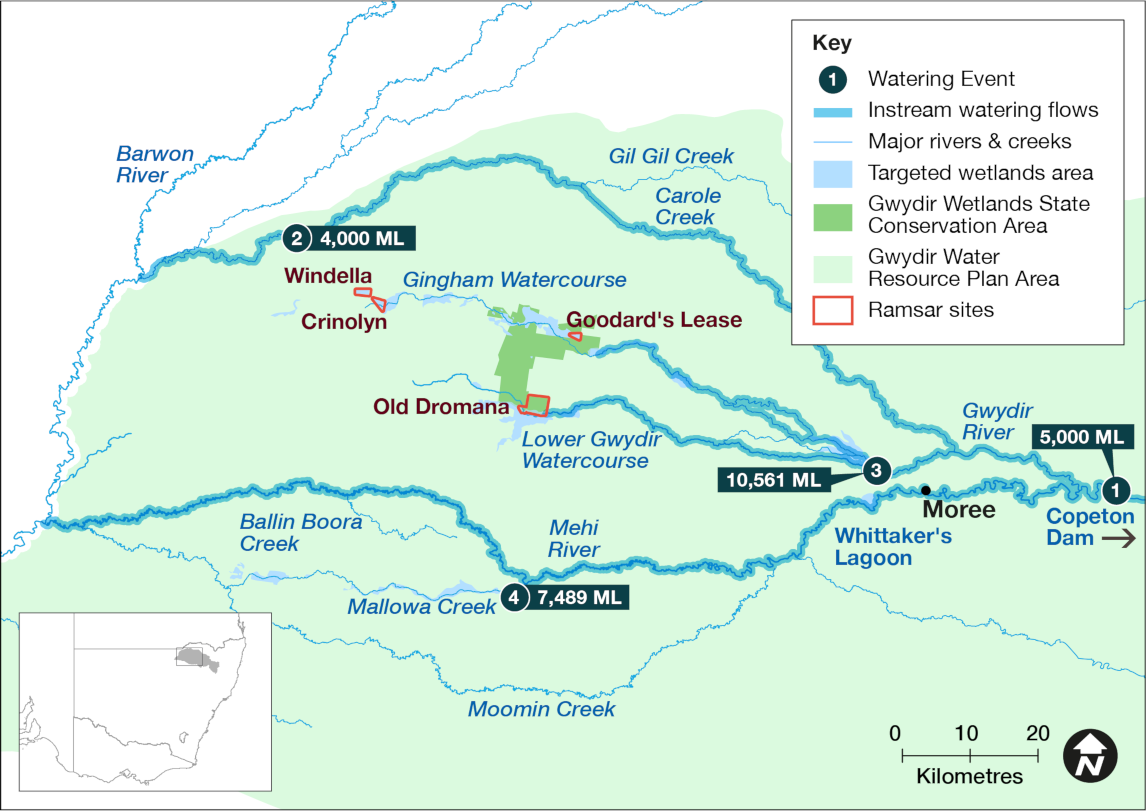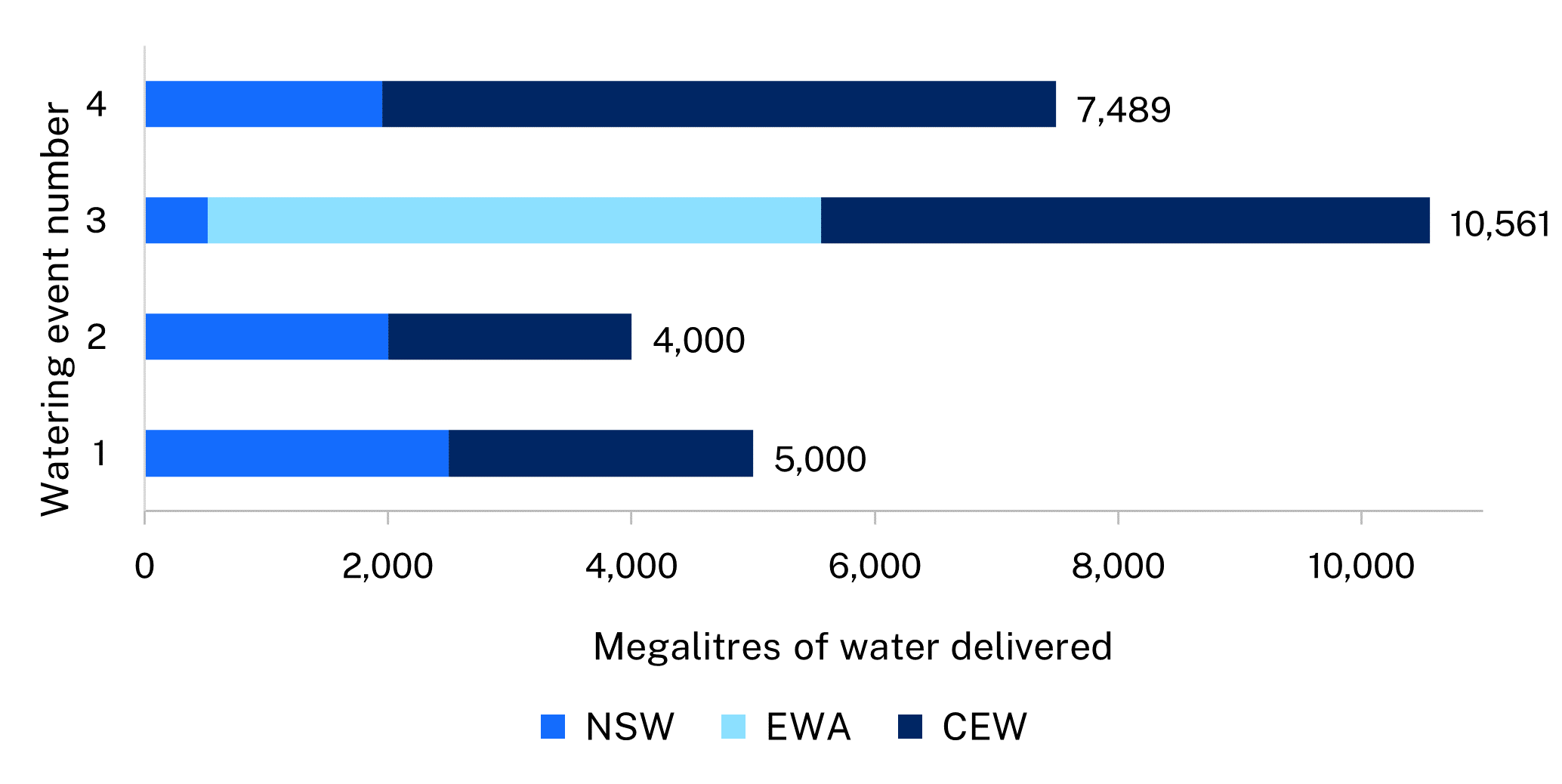Supporting native fish communities, watering wetlands after fire, and connectivity were the focus of environmental flows in 2023–24.
Key outcomes
In 2023–24, moderate conditions were experienced throughout the catchment. Water was delivered to support water-dependent plant and animal communities across the Gwydir catchment. Environmental water managers worked with partner agencies and stakeholders to deliver water for the environment, which:
- provided an early season stimulus flow for river productivity, downstream of the Copeton Dam into the Gwydir River, Carole Creek and Mehi River
- supported river connectivity through the Gwydir River system into the Barwon River via Gil Gil Creek
- refilled the 3 major waterholes along the Gingham Watercourse system
- contributed to the resilience of wetlands and the watercourse habitats of the Mallowa Creek
- provided flows into the Big Leather–Lower Gwydir watercourse to help restoration of vegetation communities across the Gwydir Wetlands State Conservation Area after fires in autumn 2024.

Map of the Gwydir catchment showing locations of water for the environment deliveries made in the 2023-24 water year with corresponding volumes.
Catchment conditions
During 2023–24, the Gwydir catchment experienced moderate weather conditions, combined with favourable environmental water accounts, resulting in positive water availability.
The carryover of held water from the previous water year enabled good availability of planned environmental water and general security entitlements. The planned environmental water account at the end of the 2023–24 water year was at 98%, general security 70% and high security at 100% of full share entitlements.
Partnering with Aboriginal peoples
Water for Country is environmental water use planned by the Department of Climate Change, Energy, the Environment and Water, and Aboriginal people to achieve shared benefits for the environment and cultural places, values and/or interests. In the 2023–24 water year, environmental water managers further developed and established relationships with Aboriginal groups and people by:
- supporting 2 Aboriginal members on the Gwydir Environmental Water Advisory Group to engage with the group’s process
- assisting the Ozfish Moree Chapter to connect with the local Aboriginal community and achieve outcomes at Whittaker’s Lagoon – the project seeks to use the lagoon area as an outdoor classroom for Aboriginal youth to connect with Country and gain cultural and river restoration knowledge
- including ‘Support for the Ozfish project at Whittaker’s Lagoon’ as a watering principle within the annual water planning of the Gwydir Environmental Water Advisory Group from the 2023–24 water year onwards.
The establishment of the Gwydir Aboriginal environmental water group is led by the Gwydir Reconnecting Watercourse Country program . This group is being supported by various government agencies at the federal and state level.
Meetings have been held with Aboriginal groups and individuals from across the Gwydir valley including Moree, Collarenebri and Mungindi local Aboriginal land councils, Gomeroi Native Title Applicant group, Moree Elder’s group, youth and health service providers. The Gwydir Aboriginal environmental water group will work and provide advice on issues connected to environmental water. Work areas will include flow deliveries, culture, two-way knowledge sharing and environmental outcomes.
Watering aims
Under expected moderate to wet weather and water availability, the Gwydir Environmental Water Advisory Group developed its Annual environmental water priorities in the Gwydir catchment 2023–24. The annual water planning process ensures that water-dependant assets are protected over the long term.
Objectives for the use of water for the environment were to:
- support waterbird breeding events triggered by natural floodplain inundation
- support and build further wetland resilience in key water-dependent vegetation communities, in particular the Mallowa Wetlands
- create and support flow events to help recruitment of native fish into the local population
- support environmental, cultural, and social aspects of Whittaker’s Lagoon.
Other objectives were to:
- support Barwon River connection flows via Mehi River and/or Carole Creek
- protect refuge pools during low and cease to flow conditions
- facilitate unplanned contingency requiring water for the environment, for example, promote wetland recovery following fires
- maximise carryover for use in future dry times.
During the 2023–24 water year, flows supported native fish across the Gwydir River system, providing connectivity into the Barwon River system. Flows delivered into the Mallowa Creek system increased watercourse and wetland resilience. Delivering water into the Big Leather–Lower Gwydir watercourse supported the restoration of wetland vegetation communities after fires spread across the Gwydir Wetlands State Conservation Area.
Water delivery
This table and chart provide a summary of 27,050 megalitres of water for the environment delivered in the Gwydir catchment during the 2023–24 watering year.
Figures were accurate at the date of publishing but may be adjusted. Watering event numbers in the table and bar chart relate to location numbers marked on the map.

Water delivery to the Gwydir catchment in the 2023-24 water year.
Notes: CEW = Commonwealth licensed environmental water; EWA = environmental water allowance accrued under the water sharing plan; NSW = NSW licensed environmental water.
| Water event number | Event name | Outcomes | Start date | Finish date |
|---|---|---|---|---|
| 1 | Early season stimulus flow | Native fish | 20 September 2023 | 27 September 2023 |
| 2 | Barwon River connect | Connectivity | 18 October 2023 | 27 October 2023 |
| 3 | Restoring natural flows | Native vegetation, waterbirds | 6 November 2023 | 19 May 2024 |
| 4 | Mallowa Creek Watercourse | Native vegetation | 11 December 2023 | 14 February 2024 |
Outcomes
In 2023–24, environmental water managers worked with stakeholders and the community to deliver flows to support a series of flow outcomes.
Water from all environmental sources was accessed this year, including planned water, as provided by the Gwydir water sharing plan and held water provided by Commonwealth Environmental Water Holder allocations.
The first of the managed deliveries began in September 2023 as an early season stimulus flow in the Gwydir River system. In total, 5,000 megalitres was delivered to support native fish communities of the Gwydir River, including Carole Creek and Mehi River, boosting in-system productivity and providing an early opportunity for spawning.
During October 2023, flows were provided from the Gwydir River into the Barwon River to maximise longitudinal connectivity. The combination of flows saw a total of 4,000 megalitres of held environmental water protected into the Barwon River via the Mehi River and the Carole-Gil Gil Creek system.
The held environmental water delivery into Mallowa Creek, its watercourse and wetlands provided ongoing support in the restoration of water-dependent communities in this system. In total, 7,489 megalitres was delivered into this watercourse over the summer.
A combination of natural flows, planned and held environmental water was directed into the Gingham Watercourse to fill 3 major waterholes. All water holes were filled by season end, providing refuge for water-dependant species through winter and into spring. In total 8,941 megalitres was delivered.
After fires burned around 900 hectares of the Gwydir Wetlands, a delivery of 1,620 megalitres of planned environmental water was made. Environmental water and natural flows added up to 4,325 megalitres and helped restore wetland vegetation. Fresh growth was observed in the days following initial flows.
The Gwydir Environmental Water Advisory Group and local landholders were provided regular communications about watering events this season via the bi-monthly State of the Gwydir Watercourses Report and Commonwealth landholder updates.
Environmental water managers monitored and managed daily water delivery rates of all flows to achieve positive outcomes by the season’s end.
Case study: watering wetlands after fire
A series of lightning strikes on 1 March 2024 ignited a large wetland fire, burning an area of approximately 900 hectares on the Big Leather–Lower Gwydir wetlands. Later in March rainfall further up the catchment triggered flows downstream of the Copeton Dam.
At the early April meeting of the Gwydir Environmental Water Advisory Group, members supported the delivery of held water in combination with natural flows to water the fire ground. This approach aimed to improve outcomes for the wetland vegetation communities, particularly the marsh club-rush stand across the burnt area.
Unexpected events are included in the annual planning of the Gwydir Environmental Water Advisory Group, under Principle 7 - Contingencies, to cater for events that may require water for the environment to support an improved ecological outcome. Examples include algal blooms, wetland fires and fish kills.
As the forecast upstream river flows spilled across the fire ground, water managers tracked the water coverage via satellite imagery. A number of field visits and assessments were conducted to validate the imagery.
As the upstream natural flows reduced, 1,620 megalitres of water for the environment was delivered to the fire ground. This provided almost complete coverage of the approximate 900 hectares burnt by fire. The held environmental water, in combination with natural flows, resulted in 4,325 megalitres being delivered from 15 April to 2 May 2024.
Ground observations and satellite imagery indicated strong vegetation response in the days immediately following the water’s arrival. Vegetation monitoring is ongoing to determine the benefits and ecological outcomes of watering wetlands after fire. These results will provide future water managers with a better understanding of watering wetlands after fire and how the wetlands may respond when fire returns.
The Ramsar-listed Old Dromana part of the Gwydir Wetlands with club-marsh rush and waterbirds.